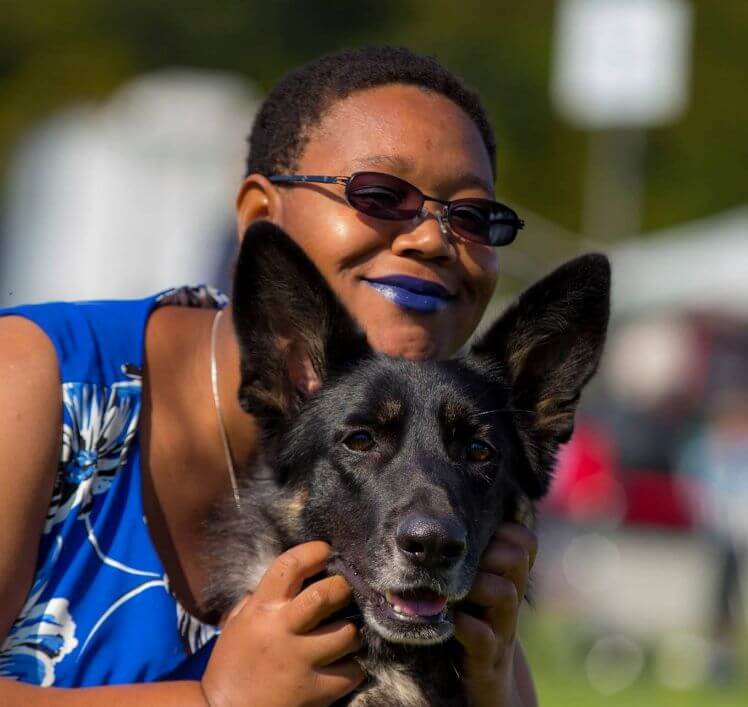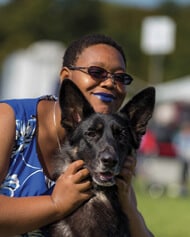Interview with a Herding Group Breeder Jackie Short-Nguyen
Where do I live? How many years in dogs? How many years as a breeder?
Jackie Short-Nguyen: I live in Western Pennsylvania. I have been in dogs for 22 years and have been breeding for the last eight.
What is my kennel name? How many dogs do I currently keep?
Jackie Short-Nguyen: I breed under the kennel name “Marcato” and I keep 4-6 dogs at a time.
Which show dogs from the past have been my noteworthy winners?
Well, I can’t really say there are any “from the past” as my first litter is only going to be eight years old this summer. That first litter produced some great dogs, though, including my three-time Westminster competitor and multiple Group Placer, DAE OHBIS BISS GCHS Marcato’s Fire Lake HT PT TC. “Soul Eater” was breeder/owner-handled or junior-handled throughout his whole career. I produced several dual champions from that litter and I am very proud of every dog.
Which have been my most influential sires and dams?
Again, I haven’t been breeding long enough to have a super influential sire or dam, but my foundation bitch, GCH Mana’s 5 Cents for Advice Marcato HT TC, “Wesson,” has certainly left her mark on my kennel. I have a great-grandson of hers, and he (and his mother) are the spitting image of her. I wanted to be a “brown dog kennel” (sables) but my kennel laughs at me in bi-color.
Can I talk a bit about my facilities? Where are my puppies whelped? How are they raised?
Jackie Short-Nguyen: I don’t have “facilities” the way many people think of them. My facility is my home. Puppies are whelped upstairs in a bedroom that is designated as a puppy room. My bedroom is right across the hall, so it is easy for me to check on mom and babies throughout the night. Puppies are raised indoors and, weather permitting, experience the outdoors for the first time at 4-5 weeks of age. I have a “puppy party” when they are around eight weeks of age, when close friends come by to socialize with the babies. We eat cheesecake, take pictures, and evaluate babies.
What is my “process” for selecting show puppies? At what age do I make my decisions?
Jackie Short-Nguyen: I do not have a specific process. I watch and evaluate puppies from the moment they are born and do so throughout their lives. I pick my show prospects at six weeks of age.
The GSD is uniquely presented, both standing and moving. How do I prepare my pups for the show ring?
Jackie Short-Nguyen: This isn’t a question I can answer in a straightforward manner. I train my dogs intuitively, not through specific practice. While the end result is the same for all dogs, the training is not. Some dogs are taught to move out ahead of me using targets, some are taught using a thrown reward, others are taught through being doubled. It depends on the animal I have in front of me.
Care to comment on the various coat colors of the breed? Any personal preferences?
Jackie Short-Nguyen: I have no particular opinion on coat colors within the breed in terms of what others breed or own. I personally prefer dark dogs, with bi-colors being my favorite. I do have many black and tans, but they need to be “dark.” I dislike faded saddles and open faces. I do feel it is high-time white dogs be accepted in conformation.
What are my thoughts on the various “styles” of GSD seen in the US and around the world?
Jackie Short-Nguyen: The split is vast, frustrating, and won’t be going anywhere. There are issues with all styles and great attributes in all styles. I personally breed American show lines and the occasional working line-cross litter.
Do I compete with my dogs in Companion and Performance events? Are Specialties important?
Jackie Short-Nguyen: I compete in herding trials with my personal dogs and I’m starting to do more Fast CAT and CAT tests. I hope to return to Agility someday. Are Specialties important? For me, not particularly. I don’t think I see significantly better animals at Specialties as opposed to all-breed shows. I also do not feel that Specialty judges are inherently more knowledgeable. Judging is a subjective endeavor, all around, and there are all-breed judges I would run to show to and breeder-judges I won’t give an entry.
In my opinion, is my breed in good condition overall? Any trends that warrant concern?
Jackie Short-Nguyen: The breed is doing “ok.” However, in my opinion, there is a lot of linebreeding and not enough outcrossing happening. Temperaments are improving, but are still not always what I like to see, including in some of my own animals that have been produced. I would love to see the breed move away from so much doubling, as it frequently makes dogs look terrible in their performance and gives inaccurate insight as to how they move.
Is the GSD well-suited to be a family dog? Who are the best candidates to own my breed?
Jackie Short-Nguyen: The German Shepherd Dog is supremely well-suited to be a family dog, if the owner is dedicated and makes sure their needs are met. GSDs are not a breed for people who want to do little more than take their dog for a stroll around the block. They are active, intelligent, “drivey” animals that should want to work. By no means should this mean that they are incapable of settling if the weather is bad and they can’t have their exercise for the day… but they aren’t meant for holding down a couch.
Do I feel that my breed is supported by a sufficient number of preservation breeders?
Jackie Short-Nguyen: That’s hard to say. There are certainly a large number of breeders out there, but with the varying opinions on what preservation breeding is, I can’t give a definitive answer.
For a bit of fun, what’s the most amusing thing I’ve ever experienced with a GSD?
Jackie Short-Nguyen: My first GSD, “Strauss,” was taught to play dead. I would tell him, “Bang! Dead Dog!” and he would fall over with a dramatic groan. (That part I didn’t teach him.) Sometimes, he would thump his tail and I would say, “Dead dogs don’t wag their tails!” He would stop wagging and lay completely still. People got a huge kick out of it.









